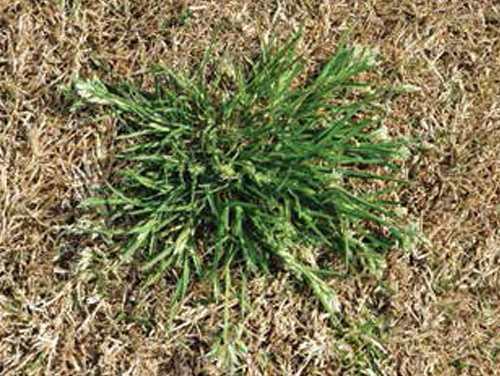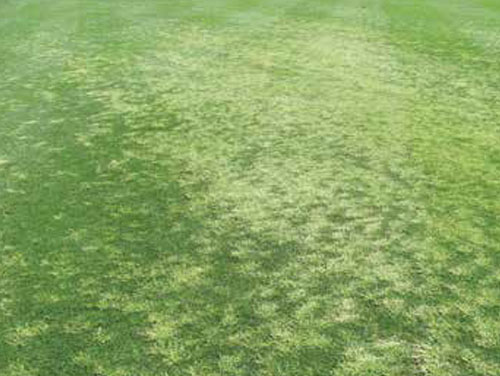Poa Annua Overview
Considered the world’s worst turfgrass weed, Winter Grass or Annual Bluegrass (Poa Annua) is a yellow-green winter annual reaching about 175 mm in height when not mowed. Read on to learn more about Poa Annua and Envu's available solutions.
Overview
The problem
Considered the world’s worst turfgrass weed, Winter Grass or Annual Bluegrass (Poa annua) is a yellow-green winter annual reaching about 175 mm in height when not mowed. Winter Grass can be very unsightly on dormant Couchgrass or Zoysia Grass. Winter Grass is also objectionable on golf greens due to its colour and growth habit, as well as production of whitish-coloured seedheads that negatively deflect ball roll.
What to look for
The majority of seed germinates in late summer to early autumn when several consecutive days of about 22–25°C highs occur. Earlier germination may occur in shaded or wet areas, or at higher elevations. Some germination can continue into early spring. Seedheads are light green to whitish and can withstand mowing heights found on golf greens. The majority of seedheads are formed during early spring. Up to 6000 seeds are produced by each plant, which can remain viable for at least six years. Poa Annua eventually dies in early summer with the onset of heat, leaving voids in the turf.
To compound the problem with control of this important weed, Winter Grass has become resistant to several classes of chemistry: sulfonylurea herbicides, glyphosate, dinitroaniline herbicides and triazine herbicides. Resistance also has been reported for ethofumesate and pronamide. Rotating between herbicides with different modes of action is the best means of preventing or at least delaying resistance occurrence.
The solution
Non-overseeded turf
In non-overseeded warm-season turf, Winter Grass control begins with an application of a pre-emergent herbicide. Specticle® and Ronstar® provide outstanding control of winter grass in addition to many other winter annuals. Pre-emergent herbicides should be applied prior to Poa Annua germination in the autumn.
For post-emergent control, Tribute® provides excellent control of winter grass in Couchgrass and Zoysia Grass. Destiny® will provide suppression on winter grass in Kikuyu turf. Apply either of these post-emergent solutions in mid-to-late autumn once small plants are visible. Repeat in late winter or early spring if additional germination occurs.
Over-seeded turf
In warm-season turf to be overseeded with Perennial Ryegrass, control becomes more complicated, requiring multiple steps. Wait as long as possible in autumn to overseed. This ensures more winter grass germination prior to overseeding. Apply Tribute at labelled rates seven days prior to overseeding to control any emerged winter grass plants. In situations where Couchgrass goes completely dormant in winter, *Tramat can be used. Four sequential monthly applications are needed for effective control.
*Tramat has been discontinued under Envu.
Technical Information
| Solution1 | Rate | Notes |
| Control in Couchgrass and Zoysia | ||
| Tribute | 1.5 litres per hectare | A repeat application may be required if a dense weed cover or larger plants are present. |
| Suppression in Kikuyu | ||
| Destiny | 150 g per hectare |
Always apply with a non-ionic surfactant or Hasten at the recommended rate on the surfactant product label. |
| Control in Ryegrass, Kentucky Bluegrass, Queensland Blue Couch and Kikuyu | ||
| Tramat | 0.8 litres per hectare | Apply first application one month before germination. Repeat at monthly intervals for three to four months. In dry conditions, watering will improve residual action. Preferably mow immediately before spraying or leave as long as possible after spraying before next mowing recommended. |
| Pre-Emergent Herbicide Control In Warm Season Turf | ||
| Specticle | 250 mL/ha in 200 to 500 L water per ha |
Turf should be in robust and healthy condition at the time of treatment. Apply prior to germination of the weeds. Ensure adequate coverage for optimum weed control. A repeat application may be required after no less than three months. Do not apply more than two applications per annum. |
| Pre-Emergent Control In Warm Season Turf | ||
| Ronstar | 200 kg per hectare | Apply using a properly calibrated granular applicator which will apply the granules in a uniform pattern. Uniform application is essential for satisfactory weed control. Calibrate the applicator prior to use according to the manufacturer's instructions, and check applicator frequently to ensure that the equipment is working properly. Ensure that the turf area is free of leaves and other debris, mowing if necessary, so that the granules reach the soil surface. If rain is not received within two days of application, apply thorough sprinkler irrigation to wash granules off the leaves and help distribute the granules on the soil surface. DO NOT apply granules when the turf foliage is wet. |
 |
 |
| Close-up of Winter Grass (Poa Annua). Photo: Dr Bert McCarty, Clemson University. |
In Ryegrass overseeded turf, Poa Annua is largely not noticed until early spring when it forms numerous objectionable, whitish-coloured seedheads. Complete control in overseeded turf is difficult to achieve and requires a strategy of proper herbicide selection and overseeding timing. Photo: Dr Bert McCarty, Clemson University. |
To find out more information about Envu's products and services, reach out to our team.
Always read the label before use.
Back to Poa Annua
